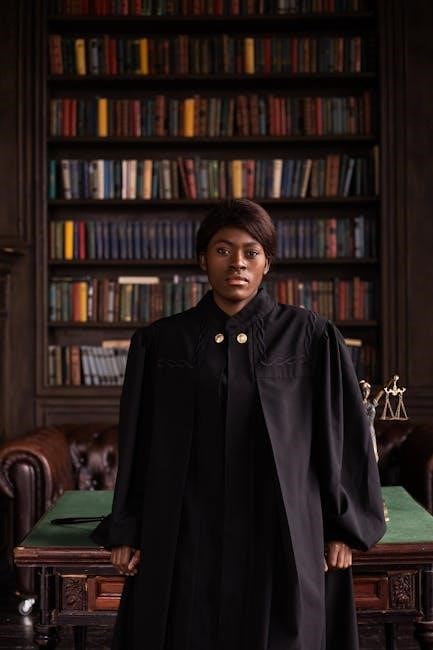
Act 1 of Romeo and Juliet introduces the feud between Montagues and Capulets, setting the stage for tragic events. Key characters like Romeo, Juliet, and Tybalt emerge, showcasing love, hate, and impulsive decisions that drive the plot. The act establishes themes of loyalty, duty, and personal desire, while pivotal scenes like the Capulet ball and Romeo’s vow foreshadow the inevitable conflict.
Overview of the Play and Its Significance
Romeo and Juliet, a tragic love story by Shakespeare, explores themes of love, hate, and fate amidst a bitter family feud in Verona. Act 1 introduces the conflict between the Montagues and Capulets, setting the stage for the star-crossed lovers’ meeting. The play’s significance lies in its timeless exploration of human emotions, impulsivity, and the devastating consequences of unresolved conflicts. As a cornerstone of literature, it remains a vital study in schools, offering insights into universal themes and complex characters. Its enduring appeal highlights the power of love and the tragedy of division, making it a foundational text for understanding Shakespearean drama.

Setting of the Play
The play is set in Verona, Italy, where a bitter feud between the Montagues and Capulets dominates the city. Act 1 introduces the setting of conflict and rivalry, establishing Verona as a place of tension and tragic events.
The City of Verona and the Feud Between Montagues and Capulets
Verona, a bustling Italian city, serves as the backdrop for the tragic events of Romeo and Juliet. The city is divided by a long-standing feud between the Montagues and Capulets, two powerful families whose animosity shapes the play’s conflict. Act 1 establishes this rivalry, highlighting its impact on the characters and the city’s tense atmosphere. The feud is central to the plot, driving impulsive actions and tragic consequences. Verona’s setting underscores themes of loyalty, duty, and personal desire, while the familie’s hatred fuels the play’s dramatic tension and foreshadows the inevitable heartbreak.

Characters Introduced in Act 1
Act 1 introduces key characters: Romeo, a lovesick Montague; Juliet, a naive Capulet; Tybalt, Juliet’s fiery cousin; and the authoritative Prince of Verona.
Romeo: His Personality and Emotional State
Romeo, a Montague, is introduced as a melancholic and romantic young man, deeply infatuated with Rosaline. His emotional state is volatile, shifting from despair to hope. His personality reveals a poetic and introspective nature, yet also impulsive and driven by emotion. Romeo’s love for Rosaline dominates his thoughts, showcasing his romantic idealism. However, upon meeting Juliet, his focus shifts, highlighting his capacity for intense passion. His mood swings and sensitivity underscore his youth and immaturity. Romeo’s emotional journey in Act 1 sets the stage for his tragic impulsiveness and deep capacity for love.
Juliet: Her Character and Family Background
Juliet, a Capulet, is introduced as a young, naive, and obedient daughter, aged 13. She is deeply loyal to her family but begins to show independence in her thoughts. Her family, particularly Lord and Lady Capulet, expect her to marry Paris, a union arranged for social advantage. Juliet’s initial hesitation reflects her immaturity and lack of experience with love. Her character evolves as she navigates her feelings for Romeo, revealing a deeper capacity for love and self-awareness. Juliet’s family background and societal expectations shape her decisions, highlighting the tension between duty and personal desire in her young life.
Tybalt: The Hotheaded Capulet
Tybalt, Juliet’s cousin and a member of the Capulet family, is portrayed as a fiery and aggressive character in Act 1. Known for his hatred of the Montagues, Tybalt is determined to uphold the family feud. His volatile nature is evident when he recognizes Romeo at the Capulet ball and demands his removal, showcasing his impulsive and confrontational personality. Tybalt’s skills as a swordsman and his pride in his family’s honor further highlight his role as a antagonist. His actions in Act 1 set the stage for future conflicts, emphasizing the destructive nature of the ongoing rivalry between the two families.
Lord and Lady Capulet: Their Roles in the Family
Lord and Lady Capulet are central figures in Juliet’s life, representing authority and tradition. Lord Capulet, as the patriarch, is assertive and insistent on maintaining family honor, particularly through Juliet’s marriage to Paris. Lady Capulet, though less prominent, supports her husband’s decisions and encourages Juliet to prioritize duty over personal feelings; Both parents are focused on securing their family’s social standing, often prioritizing practicality over Juliet’s emotions. Their interactions with Juliet highlight the societal expectations placed on women, as they emphasize obedience and marital duty. Their roles in Act 1 establish the familial pressure Juliet faces, contributing to the play’s exploration of duty vs. desire.
The Prince of Verona: His Authority and Warnings
The Prince of Verona holds significant authority as the ruler of the city, striving to maintain peace and order. In Act 1, he intervenes in the brawl between the Montagues and Capulets, sternly warning both families to end their feud. His presence emphasizes the societal consequences of their ongoing conflict, as he threatens harsh punishments for further violence. The Prince’s warnings highlight the escalating tension and the need for resolution, while also showcasing his role as a mediator attempting to uphold justice and stability in Verona. His authority serves as a reminder of the broader societal implications of the families’ rivalry.

Themes in Act 1
Themes of love, hate, impulsiveness, and loyalty emerge, setting the stage for tragic conflict and character development.
Love vs. Hate: The Central Conflict
In Act 1, the contrasting themes of love and hate are introduced, fueling the tragic narrative. The longstanding feud between the Montagues and Capulets embodies hate, while Romeo’s infatuation with Rosaline and his instantaneous love for Juliet represent the redemptive power of romance. The clash between these emotions creates tension, as seen in the violent brawl in Scene 1 and the serene balcony scene. Shakespeare highlights how hate perpetuates conflict, while love, though pure, is doomed by societal divisions. This duality sets the stage for the play’s tragic trajectory, emphasizing the destructive nature of hatred and the fleeting beauty of love.
Impulsiveness and Rash Decisions
Impulsiveness drives the plot of Act 1, as characters act on emotion without considering consequences. Romeo’s sudden shift from loving Rosaline to Juliet exemplifies this, showcasing his mercurial nature. His decision to attend the Capulet ball and declare love for Juliet is rash, igniting the central conflict; Similarly, Tybalt’s aggressive reaction to Romeo’s presence highlights his hot-headedness, foreshadowing future violence. Lord Capulet’s impulsive decision to allow Romeo to stay at the ball despite the feud further accelerates the plot. These impulsive actions underscore how emotional decisions, often made in haste, propel the characters toward tragic outcomes, emphasizing the play’s themes of passion and recklessness.
Loyalty and Duty vs. Personal Desire
In Act 1, the tension between loyalty to family and personal desire becomes a central theme. Juliet, bound by duty to her family, faces internal conflict when her heart draws her to Romeo, a Montague. Her parents, Lord and Lady Capulet, expect unwavering loyalty, arranging her marriage to Paris despite her objections. This clash highlights the societal expectation of obedience versus individual longing. Similarly, Romeo’s loyalty to his family is tested when he pursues Juliet, demonstrating how personal desire often overrides familial duty. This conflict sets the stage for the tragic events that unfold, as characters prioritize love over obligation.

Key Scenes in Act 1
The opening brawl, Romeo’s heartache for Rosaline, the Capulet ball, Romeo and Juliet’s enchanting first meeting, and the iconic balcony vow shape the act’s emotional foundation.

Scene 1: The Fight Between Montagues and Capulets
The opening scene introduces the bitter feud between the Montagues and Capulets in Verona. A public brawl erupts, involving servants and members of both families. The Prince of Verona intervenes, condemning the violence and warning both families to end their rivalry. This scene establishes the central conflict of the play, highlighting the deep-seated hatred and impulsiveness that drive the characters. It also sets the stage for the tragic events that will unfold, as the families’ animosity creates a volatile environment. The scene emphasizes the destructive nature of their feud and the societal tensions that complicate the characters’ lives.
Scene 2: Romeo’s Love for Rosaline
In Scene 2, Romeo expresses his deep sorrow over his unrequited love for Rosaline, a woman who has sworn to remain chaste. Romeo’s emotional turmoil is evident as he describes his heartache to Benvolio, who advises him to forget Rosaline and find another love. Romeo’s language is poetic and melancholic, showcasing his romantic and idealistic nature. This scene highlights Romeo’s sensitivity and tendency to fall deeply in love, setting the stage for his later encounter with Juliet. It also contrasts Romeo’s introspective personality with the external conflict of the feud, emphasizing his emotional depth and vulnerability.
Scene 3: The Capulet Ball and Romeo’s Arrival
Scene 3 takes place at the Capulet ball, where Lord Capulet hopes to secure a marriage between his daughter Juliet and Paris, a wealthy suitor. The ball is a grand affair, filled with music, dancing, and celebration. Romeo, still heartsick over Rosaline, attends the ball with his friends Benvolio and Mercutio, who encourage him to forget his sorrow. Romeo’s decision to crash the ball highlights his impulsive nature and sets the stage for his fateful encounter with Juliet. The scene showcases the opulence of the Capulet household and the societal expectations surrounding Juliet, while also deepening Romeo’s emotional complexity and foreshadowing the tragic events to come.
Scene 4: Romeo and Juliet’s First Meeting
Scene 4 marks the poignant first encounter between Romeo and Juliet at the Capulet ball. Romeo, captivated by Juliet’s beauty, forgets his sorrow over Rosaline and approaches her. Their exchange is filled with romantic and poetic language, revealing their instant attraction. Juliet, though young and inexperienced, responds with sincerity, while Romeo declares his love passionately. The scene highlights the intensity of their emotions and the immediate connection between them. This meeting sets the tragic events in motion, as their families’ feud looms over their blossoming love. The encounter is both magical and foreboding, showcasing the power of love amidst conflict.
Scene 5: The Balcony Scene and Romeo’s Vow
Scene 5, the iconic balcony scene, captures Romeo and Juliet’s deepening bond. Juliet, unaware of Romeo’s presence, confesses her love for him on her balcony. Romeo, hiding in the shadows, reveals himself, and they exchange vows of love. Juliet expresses her desire to be with Romeo despite their families’ feud, while Romeo promises to make their love possible. The scene is rich in poetic language, with Romeo’s famous line, “What light through yonder window breaks?” showcasing his adoration. Their vows highlight the intensity of their emotions and the challenges they face due to their families’ hatred. This moment solidifies their tragic destiny.

Key Quotes and Their Significance
These quotes highlight themes like fate, love, and identity, providing insight into characters’ emotions and the play’s tragic undertones, crucial for understanding the narrative.
“From forth the fatal loins of these two foes”
This quote, spoken by the Chorus in the Prologue, introduces the tragic fate of the Montagues and Capulets. It highlights the inevitability of conflict and the destructive nature of their feud. The phrase “fatal loins” suggests that the families’ hatred will produce tragic consequences, specifically the births of Romeo and Juliet, whose union will ultimately lead to their demise. This line sets the tone for the play, emphasizing fate’s role and the cyclical violence between the families. It underscores the idea that the characters’ actions are driven by forces beyond their control, foreshadowing the devastating outcome of their story.
“What light through yonder window breaks?”
This iconic line, spoken by Romeo in Act 2, captures his enchantment upon seeing Juliet on her balcony. However, its significance extends beyond romance, reflecting themes of hope and illusion. Romeo’s words symbolize the transformative power of love, as he views Juliet as a source of light amidst the darkness of the feud. The quote also highlights Romeo’s poetic and idealistic nature, showcasing his deep emotional connection to Juliet. It sets a dreamlike tone, emphasizing the fleeting beauty of their love and foreshadowing the tragic events that will unfold. This line remains one of Shakespeare’s most celebrated, embodying the essence of romantic longing.
“O Romeo, Romeo, wherefore art thou Romeo?”
This poignant line, spoken by Juliet in Act 2, expresses her deep longing for Romeo and her frustration with the familial feud that separates them. It highlights Juliet’s emotional turmoil and her desire to transcend the hatred between their families. The quote underscores the central theme of love vs. hate, as Juliet implores Romeo to abandon his name, symbolizing the conflict between loyalty to family and personal desire. This iconic soliloquy showcases Juliet’s maturity and passion, as she grapples with the reality of her situation. It also foreshadows the tragic consequences of their love, leaving the audience with a sense of impending doom and heartache.

Analysis of Act 1
Act 1 masterfully introduces the feud, characters, and themes, establishing the tragic foundation. It showcases the explosive tension between families and the impulsive nature of the lovers.
The Establishment of the Feud and Its Consequences
The feud between the Montagues and Capulets is central to the play, creating a tense atmosphere in Verona. Act 1 highlights the deep-seated hatred through the brawl and the Prince’s warning, emphasizing its destructive nature. This ongoing conflict fuels impulsive decisions, such as Romeo’s defiance at the ball and Tybalt’s vengeful anger. The feud’s consequences are immediate, as it isolates the lovers and sets the stage for tragic events. Shakespeare uses the feud to explore themes of loyalty, duty, and the devastating impact of unchecked animosity, making it a pivotal element in the play’s progression and character motivations.
The Accelerated Plot and Character Development
Act 1 of Romeo and Juliet is marked by rapid plot progression and swift character development. The initial brawl, Romeo’s lovesickness for Rosaline, and his sudden infatuation with Juliet at the ball showcase the speed at which events unfold. Romeo’s transformation from a melancholic lover to a determined suitor highlights his impulsive nature. Juliet, too, evolves from a dutiful daughter to a strong-willed individual. Tybalt’s hatred and the Prince’s warning add urgency, while the lovers’ immediate connection intensifies the story. Shakespeare’s condensed timeline creates tension, foreshadowing the tragic consequences of hasty decisions. This pacing emphasizes the destructive power of impulsive behavior, central to the play’s themes;
Dramatic Irony and Foreshadowing
Act 1 of Romeo and Juliet employs dramatic irony and foreshadowing to heighten tension and prepare the audience for the tragic outcome. The Chorus’s opening lines, “From forth the fatal loins of these two foes,” reveal the ultimate fate of the lovers, creating dramatic irony. Romeo’s declaration, “My mind misgives some consequence yet hanging in the stars,” foreshadows the impending disaster. Tybalt’s hatred for the Montagues and his vow to confront Romeo also hint at future violence. These elements establish a sense of inevitability, drawing the audience into the unfolding tragedy while emphasizing the destructive nature of the feud and impulsive decisions.

Study Questions for Act 1
Comprehensive Questions to Test Understanding
- What is the significance of the opening brawl in Verona?
- How does Romeo’s initial infatuation with Rosaline relate to his later love for Juliet?
- What role does the feud play in shaping the characters’ actions?
- Analyze the introduction of Juliet and her family dynamics.
- What does the Capulet ball reveal about their societal aspirations?
How does the feud between Montagues and Capulets influence the characters’ behaviors in Act 1? What motivates Romeo to attend the Capulet ball, and how does this decision impact the plot? Analyze Juliet’s relationship with her parents and Nurse—how does this shape her decisions? What role does Tybalt play in escalating tensions, and what does his character reveal about the feud’s consequences? How does Shakespeare use dramatic irony in the balcony scene, and what effect does this have on the audience? What does Romeo’s vow to Juliet signify about his impulsive nature? How does the Prince’s warning to both families foreshadow future events?

Further Reading and Resources
Explore study guides, literary analyses, and essays on Romeo and Juliet Act 1 from sources like SparkNotes, CliffsNotes, and scholarly articles on JSTOR or Google Scholar.
Recommended Study Guides and Literary Analyses
For a deeper understanding of Romeo and Juliet Act 1, explore reputable study guides like SparkNotes, CliffsNotes, and LitCharts. These resources provide detailed summaries, character analyses, and thematic insights. Literary critiques from sources like JSTOR and Google Scholar offer scholarly perspectives on Shakespeare’s use of language, dramatic structure, and historical context. Additionally, essay collections and academic journals analyze the feud’s origins, Romeo’s emotional journey, and Juliet’s defiance. These materials are invaluable for students seeking to grasp the complexities of Act 1 and its role in setting the tragic tone of the play.